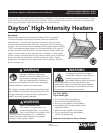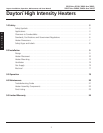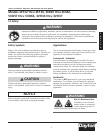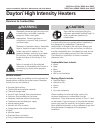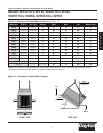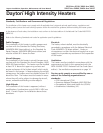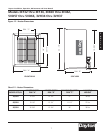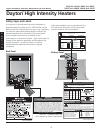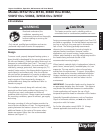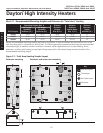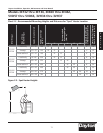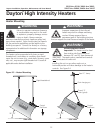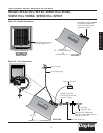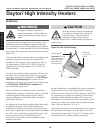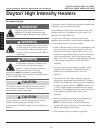
2.0 Installation
WARNING
!
!
CAUTION
!
®
Dayton Installation, Operation, Maintenance and Parts Manual
Models 3E132 thru 3E134, 3E460 thru 3E462,
5VD57 thru 5VD66, 3VH34 thru 3VH37
E
N
G
L
I
S
H
9
Read and understand, the
installation, operating and
maintenance instructions thoroughly
before installing or servicing this
equipment.
Only trained, qualified gas installation and service
personnel may install or service this equipment.
Design
To ensure a safe, properly designed heating system, a
layout should be developed for the correct placement of
the infra-red heater(s). Aside from safety factors such as
clearance to combustibles (see Chart 1.1 on page 5), you
should take into consideration: the environment (e.g.,
cold/drafty, average, protected), heat coverage (sq. ft.)
needed, heater centers, the distance behind a person or
work station(s) and exhaust path. Also, the effective
infra-red surface temperature of a person or object may
be diminished with wind above 5 mph. Wind barrier(s)
may be required. Most importantly, clearance to
combustibles must always be maintained! Refer to
hazards on page 4.
This installation manual, along with national, state,
provincial and local codes, address these issues. It is
critical that you read, understand and follow all
guidelines and instructions. Always inspect and evaluate
the mounting conditions, space for exhaust, gas supply
and wiring.
Perimeter mounting of infra-red heaters provides the
most effective distribution of heat. The recommended
spacing between the heaters is shown in Chart 2.1. Add
additional heaters in the center of the space when
heaters are spaced futher than the recommended
distance (see Figure 2.1 ).
This heater cannot be used in a building with an
uninsulated roof or condensation problems can occur.
Factory recommended mounting heights (see Chart 2.2)
are listed as a guideline. If infra-red heaters are mounted
too low or too high, they may result in discomfort or
lack of heat. The factory generally recommends
observing the recommended mounting heights to
optimize comfort conditions. However, certain
applications such as spot heating, freeze protection,
outdoor patio heating or very high ceilings may result in
the heaters being mounted outside of the
recommended mounting heights.
When heated, materials high in hydrocarbons (solvents,
paint thinner, mineral spirits, formaldehydes, etc.) can
evaporate. This may result in odors or fumes being
emitted into the environment. To correct this problem,
clean the area and/or introduce additional ventilation.
Heaters installed and serviced in accordance with the
installation manual do not emit foul odors into the
environment.
IMPORTANT: Fire sprinkler heads must be located at
an appropriate distance from the heater. This distance
may exceed the published clearance to combustibles.
Certain applications will require the use of high
temperature sprinkler heads or relocation of the heaters.
Potentially flammable substances, such as Propylene
Glycol or antifreeze solutions, are not to be used in
conjunction with this heater.
For further information consult NFPA 13. Always
observe applicable state and local codes.



